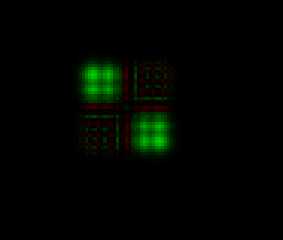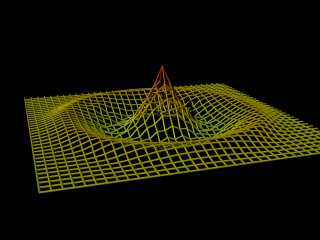 |
 |
|
 |
|
 |
|  |
|  |
|
 |
|
 |
|  |
|  |
|
 |
Invisible wrote:
> All of this has pretty much inevitably ended with... the wave equation.
OK, so I simulated the wave equation and got... this?
Hmm. I started with a green square on a black background. The corners
lit up, and plausibly wave-like projections radiated out from the
corners. But... why only those two corners? Why not all four?
I think I must have done something rather wrong here... :-S
Post a reply to this message
|
 |
|  |
|  |
|
 |
|
 |
|  |
|  |
|
 |
Invisible wrote:
> OK, so I simulated the wave equation and got... this?
Try including the attachment, dork! :-P
Post a reply to this message
Attachments:
Download 'test.png' (4 KB)
Preview of image 'test.png'

|
 |
|  |
|  |
|
 |
|
 |
|  |
|  |
|
 |
>> OK, so I simulated the wave equation and got... this?
>
> Try including the attachment, dork! :-P
I made some POV code to simulate the wave equation a long time ago, see
attached. Maybe you can compare with your code and see where it's giving
different answers?
BTW in my version it forces the central point to follow a sine wave up and
down, and that then causes the circular "ripple" effect outwards.
Post a reply to this message
Attachments:
Download 'us-ascii' (3 KB)
Download 'waves.png' (47 KB)
Preview of image 'waves.png'

|
 |
|  |
|  |
|
 |
|
 |
|  |
|  |
|
 |
scott wrote:
> I made some POV code to simulate the wave equation a long time ago, see
> attached. Maybe you can compare with your code and see where it's
> giving different answers?
How did you arrive at
#local XD = waveHeight[X+1][Y] - 2*waveHeight[X][Y] + waveHeight[X-1][Y];
According to my calculations,
(v[x-1] - v[x]) + (v[x] - v[x+1]) =
v[x-1] - v[x] + v[x] - v[x+1] =
v[x-1] - v[x+1]
which is completely different to what you have.
Post a reply to this message
|
 |
|  |
|  |
|
 |
|
 |
|  |
|  |
|
 |
Invisible wrote:
> Actually... it's possibly not directly related, but Wolfram showed a
> trivially simple cellular automaton which has no sophisticated
> properties encoded into it, and isn't even an accurate simulation of any
> physical system, and yet exhibits the same characteristics as a flowing
> liquid. (Most particularly, it has both laminar and turbulent flow.)
Cool. Where did you see this? I couldn't track down anything obvious
with Google, due to conflicting hits.
--
Darren New / San Diego, CA, USA (PST)
Post a reply to this message
|
 |
|  |
|  |
|
 |
|
 |
|  |
|  |
|
 |
>> Actually... it's possibly not directly related, but Wolfram showed a
>> trivially simple cellular automaton which has no sophisticated
>> properties encoded into it, and isn't even an accurate simulation of
>> any physical system, and yet exhibits the same characteristics as a
>> flowing liquid. (Most particularly, it has both laminar and turbulent
>> flow.)
>
> Cool. Where did you see this? I couldn't track down anything obvious
> with Google, due to conflicting hits.
Wolfram's "A New Kind of Science".
Maddeningly, I've searched and searched the online version, but cannot
find any reference to this experiment. It definitely appears in the
paper copy I have though.
(As an aside, I found the book to be somewhat dissapointing. But there
were one or two very interesting things to be found. This was one of them!)
--
http://blog.orphi.me.uk/
http://www.zazzle.com/MathematicalOrchid*
Post a reply to this message
|
 |
|  |
|  |
|
 |
|
 |
|  |
|  |
|
 |
Orchid XP v8 wrote:
> Maddeningly, I've searched and searched the online version, but cannot
> find any reference to this experiment. It definitely appears in the
> paper copy I have though.
Cool. I'll dig thru the index.
> (As an aside, I found the book to be somewhat dissapointing. But there
> were one or two very interesting things to be found. This was one of them!)
I thought a lot of it was pretty cool, and he did a good job of
organizing it into "the part you read for fun" and "the part you read if
you're actually going to do something technical with the results".
(Unlike several other tomes of this sort I've read.) Altho, yeah, the
hubris was rather astounding. :-)
I trust you've read Godel-Escher-Bach?
--
Darren New / San Diego, CA, USA (PST)
Post a reply to this message
|
 |
|  |
|  |
|
 |
|
 |
|  |
|  |
|
 |
>> Maddeningly, I've searched and searched the online version, but cannot
>> find any reference to this experiment. It definitely appears in the
>> paper copy I have though.
>
> Cool. I'll dig thru the index.
Chapter 8, "Implications for everyday systems", section title "Fluid
Flow", page 376 in my hardback copy.
He shows a cellular automaton consisting of a hexagonal grid. Each cell
may optionally contain a particle, which can have one of 6 possible
velocities. (Note that all particles have unit momentum. There is no
attempt to simulate varying particle speeds.)
When two neighboring cells both contain particles, a simple automaton
rule defines the new velocities for those particles. (Again, casually
glossing over a vast swathe of actual phenomina that occur with
molecular collisions. Here there is no vague attempt at Newton's laws of
motion, or even intuitive plausibility really.)
Viewed locally, all the particles dance around more or less at random.
However, if you average over a very large number of particles, you what
something looking suspiciously like fluid dynamics. Specifically,
Wolfram demonstrates that if all the particles have random initial
velocities, the overall net flow is zero. If a large minority of
particles all move in one direction, and there is an obsticle in the
way, you get trailing vorticies behind it. And if enough particles are
made to move the same way, you get real turbulence behind the obsticle.
All this from just individual particles interacting in a very
physically-incorrect manner. (OTOH, you have to average absurd numbers
of particles to get this, so it's very ineffient stuff!)
>> (As an aside, I found the book to be somewhat dissapointing. But there
>> were one or two very interesting things to be found. This was one of
>> them!)
>
> I thought a lot of it was pretty cool, and he did a good job of
> organizing it into "the part you read for fun" and "the part you read if
> you're actually going to do something technical with the results".
> (Unlike several other tomes of this sort I've read.) Altho, yeah, the
> hubris was rather astounding. :-)
It makes some valid points... it's just not very interesting to read.
> I trust you've read Godel-Escher-Bach?
Never heard of it.
--
http://blog.orphi.me.uk/
http://www.zazzle.com/MathematicalOrchid*
Post a reply to this message
|
 |
|  |
|  |
|
 |
|
 |
|  |
|  |
|
 |
> organ. When I started learning about the stop names, I had a second dream
> in which I accidentally killed 3 people by choosing a powerful stop.
>
Good thing you haven't been learning bag-pipes. That would have been
particularly grusome.
--
Post a reply to this message
|
 |
|  |
|  |
|
 |
|
 |
|  |
|  |
|
 |
Orchid XP v8 wrote:
> Chapter 8, "Implications for everyday systems", section title "Fluid
> Flow", page 376 in my hardback copy.
Thank you!
> All this from just individual particles interacting in a very
> physically-incorrect manner. (OTOH, you have to average absurd numbers
> of particles to get this, so it's very ineffient stuff!)
BTW, if you liked Wolfram's thing and you like science fiction, check
out "Permutation City" by Greg Egan. A very fun geeky read.
> It makes some valid points... it's just not very interesting to read.
I found it pretty interesting, but repetitive. I also really like CAs.
>> I trust you've read Godel-Escher-Bach?
> Never heard of it.
http://www.amazon.com/Godel-Escher-Bach-Eternal-Golden/dp/0465026567
Wow. I'm not sure why it came up in the conversation, but it's a
must-read for anyone who enjoys computers and waded thru Wolfram's stuff.
--
Darren New / San Diego, CA, USA (PST)
Post a reply to this message
|
 |
|  |
|  |
|
 |
|
 |
|  |




![]()